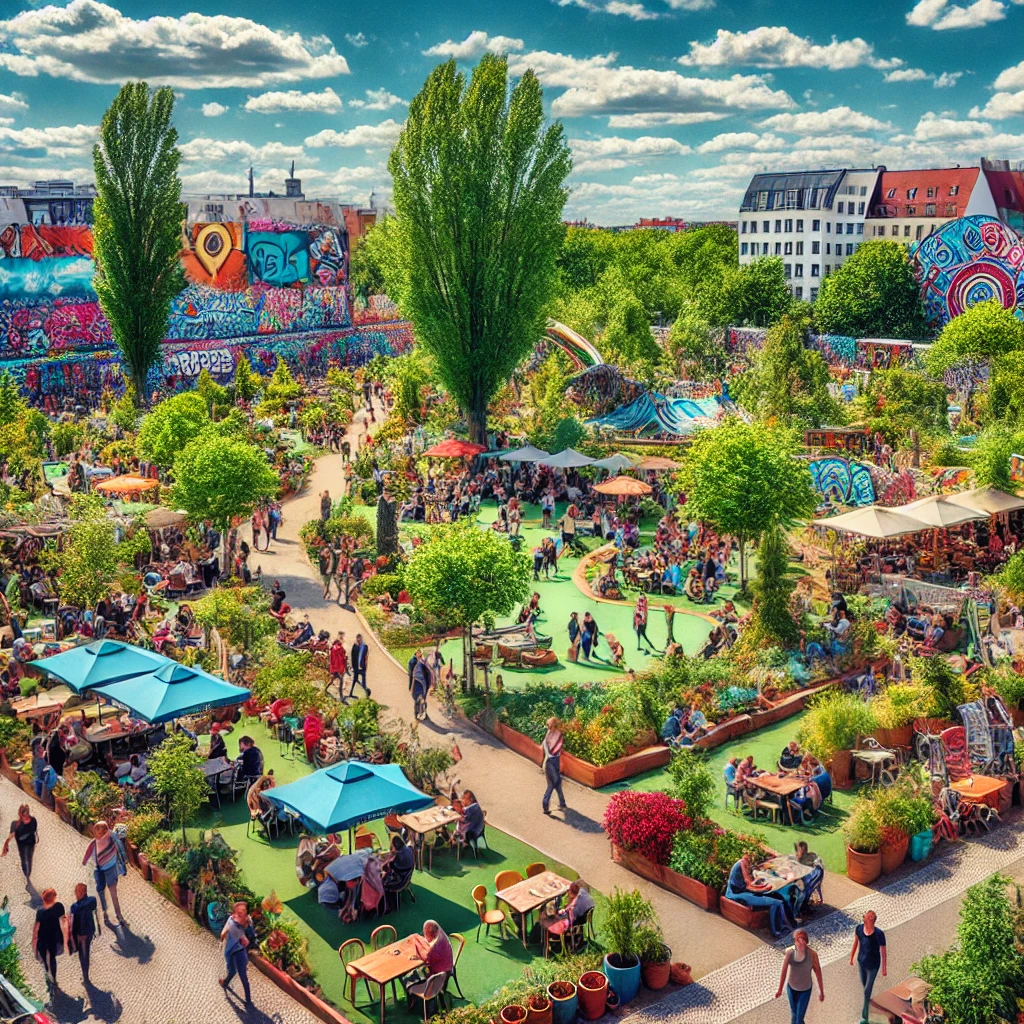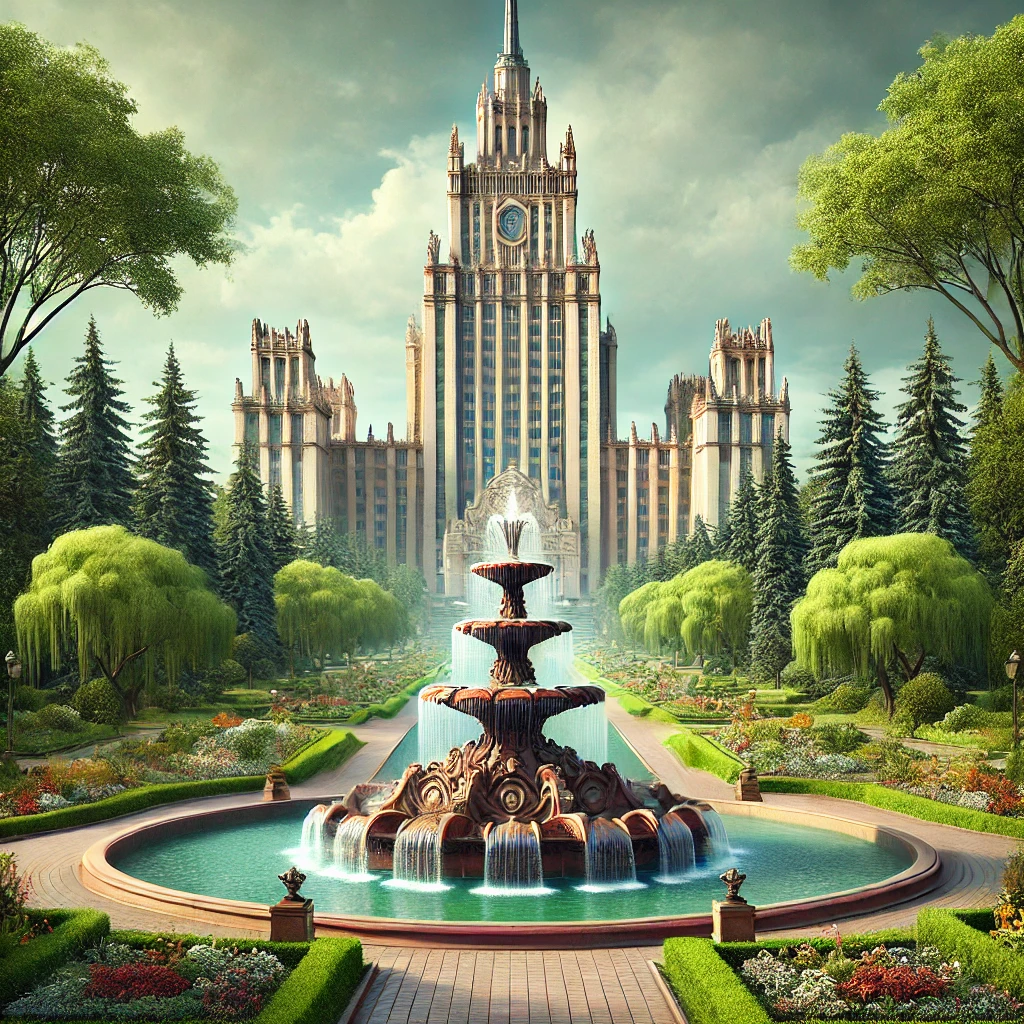Friedrichshain: from a working-class district to a trendy spot in Berlin

- Friedrichshain: Why does this place attract residents and tourists in Berlin?
- How do the historic district and park of Friedrichshain influence life in Berlin?
- Karl-Marx-Allee: the history, architecture, and current state of this famous street
Friedrichshain: Charm in East Berlin
Friedrichshain is a charming district located on the eastern side of Berlin. Once a hub of industry and home to workers, this part of the city has undergone a dramatic transformation in recent years. It is now considered one of the trendiest and most attractive areas of the German capital, drawing in affluent individuals.
This area is home to a variety of establishments, including bars, clubs, cafes, and pubs, primarily concentrated around Simon-Dach-Strasse and Boxhagener Square.
Historical context of the area
Friedrichshain is part of the larger administrative district of Friedrichshain-Kreuzberg, which was created as a result of significant administrative changes that took place in Berlin in early 2001, when Friedrichshain was separated from the list of individual districts.
Title and geography
The name of this district is associated with Friedrichshain Park, which is also referred to as "Friedrich's Grove." This green corner was established in honor of the Prussian King Frederick II. Geographically, Friedrichshain is located to the north of the park and ends at the Spree River to the south.
Gentrification and neighborhood transformation
In recent years, this area has become a symbol of a successful gentrification program — a process that transforms once poor and neglected neighborhoods, making them attractive to a wealthier segment of the population. In the past, there were factories and workshops here, but now Friedrichshain has become a trendy and prestigious place for high-income residents to live.
The real estate market in Friedrichshain
The demand for this area is also reflected in the real estate market.
- The average cost per square meter— about 5,250 euros according to data published by Immowelt in April 2022.
- Currently, there are 11 properties for sale in Friedrichshain, with apartments starting from411,000 euros.
- For example, there are new apartment complexes on the market where apartments are offered starting from 2024.411,000 euros.
- There is also an offer for the sale of a four-room penthouse with a total area of149 m²for1,175,000 euros.
- For1,250,000 eurosIt is possible to purchase a three-bedroom penthouse with an area of143 m².
- Three-bedroom penthouse with two terraces covering an area of155 m²offered for1,500,000 euros.
Available housing options
For those looking for more affordable housing options, there are offers available:
- Two-bedroom apartments in new residential complexes, where the yield is3.3%— from420,000 eurosfor apartments with an area of59 square meters.
- New three-room apartments —530,000 eurosfor70 square meters.
- Real estate with tenants — from345,000 eurosfor apartments in historic buildings with an area of65 square meters.
The historical heritage of Friedrichshain
Friedrichshain is also famous for its historical neighborhoods, among which the following stand out:
- Shtralauka suburb
- Boxhagen
- Part of Eastern Königsstadt
These areas are known for their rich history. Until 1920, this district was divided into several parts by the city boundary, which is evident from iconic landmarks such as the Frankfurt Gate and the Oberbaum Bridge.
Conclusion
All of these aspects make Friedrichshain a unique place with diverse architecture and cultural heritage, giving it a special appeal to new residents and tourists. Life in this area is filled with vibrant events and a rich cultural program, making it one of the main attractions in Berlin.
The historical significance of the area
In 1945, this area suffered significant destruction due to intense bombings and fierce street battles, resulting in the near-total disappearance of Frankfurter Allee. Later, during the existence of the German Democratic Republic, the street was restored and given a new name — Stalin Avenue. This place attracts attention with its unique Stalinist architecture, sometimes referred to as "palaces for workers."
Over time, in 1961, this street changed its name again to Karl-Marx-Allee. It is worth noting that Karl-Marx-Allee is protected as a cultural monument, highlighting its significant architectural heritage.
Friedrichshain Park
Not far from this area is Friedrichshain Volkspark, which has become one of the favorite spots for city dwellers to relax. Inside the park is the "Fairy Tale Fountain," built in 1913 under the guidance of the famous Berlin architect Ludwig Hoffmann. This fountain has become home to numerous sculptures depicting well-known fairy tale characters, such as:
- Hansel and Gretel
- Puss in Boots
- Cinderella
- Little Red Riding Hood
- Sleeping Beauty
- Snow White and the Seven Dwarfs
Creation of a park
Volkspark Friedrichshain, also known as Friedrichshain Park, is the first urban park established in Berlin. Its creation in 1840 was timed to coincide with the centenary of Frederick II's coronation, in honor of whom the park received its unique name. The idea of creating such a large park in a densely populated area belonged to Peter Joseph Lenné, who was the director of the royal parks in Berlin at that time.
The project was carried out by his student Johann Heinrich Gustav Meyer, who later also headed the Berlin gardens.
Architecture and features of the park
The park covers an impressive area of 49 hectares and is designed in the characteristic style of English landscape parks. At its center stands a 4-meter column with a bronze bust of Frederick II, which serves as an additional reminder of the importance of this place in a historical context. The park is listed in the register of protected historical sites, which attests to its significance.
The "Fountain of Tales," built according to Ludwig Hoffmann's design in 1913, is one of the main attractions of the park. Among the figures adorning the fountain, you can find famous characters from both folk and literary tales.
Artificially created hills
In addition, the park conceals two artificially formed hills created on the site of exploded anti-aircraft bunkers after World War II. These hills are named:
- The Great Bunker Mountain (Großer Bunkerberg) is 78 meters high.
- The Small Bunker Mountain (Kleiner Bunkerberg) is 48 meters high.
Japanese garden and cultural events
A Japanese garden was also established in the park, located by the shore of a picturesque pond. In the center of this garden stands a Japanese pavilion with a "bell of peace," which was gifted to Berlin in 1989 as a symbol of the desire to prevent nuclear threats.
The park features an open-air stage that was built back in 1950, where various theatrical performances, film screenings, and concerts take place during the summer.
Comfortable infrastructure
In addition, the park offers its visitors convenient infrastructure: there are numerous gazebos, playgrounds, fountains, and ponds, as well as cozy cafes and restaurants. This creates ideal conditions for family recreation and active leisure.
Visitors to Friedrichshain Park can engage in various outdoor activities, making this place especially valuable for the peaceful life of Berliners.

This area is home to numerous sports facilities: you can find a football field, volleyball and basketball courts, as well as tables for table tennis.
9 October 2024
29 January 2025
29 September 2025
9 October 2024
The history of Karl-Marx-Allee
Karl-Marx-Allee is a famous street that runs through the districts of Mitte and Friedrichshain. It is known for its majestic residential buildings, constructed in the style of socialist classicism in East Germany during the 1950s. The design of this street was developed by a group of seven architects, among whom Hermann Henselmann holds a special place, as he later became the chief architect of Berlin and led the creation of the famous Berlin TV Tower.
Renaming of the street
Originally, this avenue was called "Big Frankfurt," but in 1949, in honor of Stalin's 70th birthday, it was renamed Stalin Avenue. Twelve years later, in 1961, after the condemnation of Stalin's cult of personality, the street was given its current name — Karl-Marx-Allee.
Concept and architecture
The idea of creating Karl-Marx-Allee was to emphasize the status of Berlin as a capital with its wide monumental streets designed for various marches and parades. The residential buildings constructed along this avenue were called "palaces for the workers." The architecture of these structures resembles the main buildings of Moscow University and the Palace of Culture and Science in Warsaw.
Architectural rivalry
The construction in the style of Stalinist architecture on Karl-Marx-Allee sharply contrasted with the modern projects that were being carried out at the same time in West Berlin, in the Hansaviertel district. This architectural rivalry symbolized the confrontation of different socio-political systems:
- Karl-Marx-Allee embodied East Berlin;
- Ganzafirtel represented the West.
Current state
After the reunification of Germany in 1990, the residential spaces on Karl-Marx-Allee were handed over to numerous investors who carried out extensive renovations and updates. As a result, this housing became quite sought after and prestigious for living. Since 1990, there has been an active discussion in Berlin about the possibility of returning the street to its original historical name — Große Frankfurter Straße.
East Side Gallery
The East Side Gallery is the largest remaining fragment of the Berlin Wall, located in the Friedrichshain district. This section has been transformed into a unique open-air art gallery. After the reunification of East and West Berlin, the Berlin Wall became an object of art. Since 1990, numerous artworks reflecting recent political events and historical changes have begun to appear on its surface along the Spree River, from Ostbahnhof station to Oberbaumbrücke.
Conclusion
In conclusion, I want to emphasize that the Friedrichshain district in Berlin represents a unique blend of history and modernity. Having transformed from a working-class settlement into a trendy and attractive hub, it has become home to many affluent residents seeking to enjoy the vibrant atmosphere and diverse leisure options. The lively scene pulsating in the bars, clubs, and cafes makes this area an ideal place for those looking for inspiration and entertainment.
Historical heritage
The special value of Friedrichshain lies in its heritage. This is an area where you can feel the spirit of the times by visiting Friedrichshain Park with its historical monuments and natural beauty.Fountain of Taleswhich delights both children and adults, is a symbol not only of the district's history but also of a love for art and culture. This place is filled with history, reminding us how a city can change and adapt while preserving its identity.
The challenges of gentrification
It is also worth noting that the successful gentrification of Friedrichshain is not without its challenges. The rising cost of housing can become a barrier for those who once lived here and for whom this area has always been home. Therefore, it is important to find a balance between development and the preservation of this unique place, so that it remains accessible to everyone.
Hopes for the future
While in Friedrichshain, I can't help but notice how the neighborhood continues to attract a new generation, blending tradition with modernity. It's a place where history meets innovation, and I sincerely hope it retains its unique character for many years to come.
Comment
Popular Posts
9 October 2024
9942
29 January 2025
1530
29 September 2025
392
9 October 2024
1487
Popular Offers

Subscribe to the newsletter from Hatamatata.com!
Subscribe to the newsletter from Hatamatata.com!
I agree to the processing of personal data and confidentiality rules of Hatamatata














